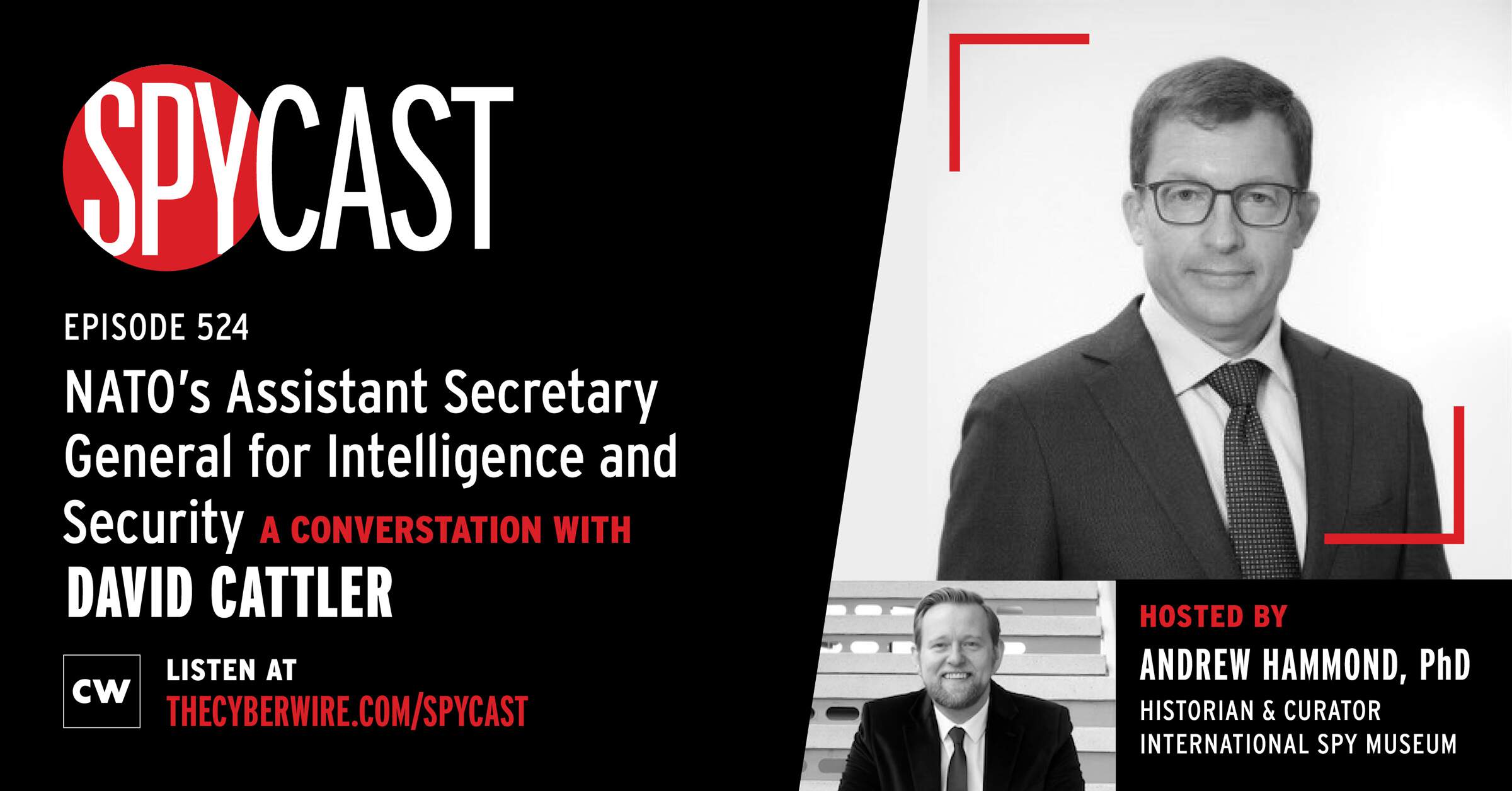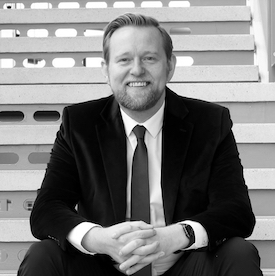
“NATO’s Assistant Secretary General for Intelligence & Security” – with David Cattler
Every polisci student knows from their Plato to NATO class, that NATO is (a) considered the most successful alliance of its kind in history and (b) was founded in 1949. As you can imagine, intelligence is incredibly important to the whole endeavor, so why has NATO only had an intelligence supremo since 2016?
To find out the answer, and much else besides, Andrew sat down with David Cattler. David is (a) the principal advisor on intelligence to the NATO Secretary General and (b) the lead for coordinating intelligence relationships between NATO and the 75 individual intelligence agencies across its 30 constituent nations (talk about herding cats).
With Russian forces built up on the Ukrainian border in February 2022, the timing of this episode is, well, germane.
And…
Andrew picked David up outside the U.S. Department of State and drove him to the SpyCast studio at SPY – if the traffic is right, you can do it in under 10 minutes!
NATO’s Intelligence Chief – A Conversation with David Cattler
Quote of the Week
"The secretary general is my boss but imagine him in this context to put it in a different frame is that he is the CEO of a large international conglomerate that engages in multiple business lines. And I am the CEO of the business line for intelligence and security. The nation's intelligence services in effect are my corporate board. So, they provide that governance and the oversight for all the work." – David Cattler
What You’ll Learn
- Intelligence and NATO
- What it is like to be the leader of intelligence and security across the largest peacetime alliance in history?
- How does intelligence come together at NATO – who are the key-players, institutions, and stakeholders?
- What are some of the main challenges facing the Alliance including Russia and Cyber?
- Career skillet
- “Reading” an institution and its key players
- The importance of “soft skills” in professional life
- And much more…
Guest Bio(s)
David Cattler is NATO’s Assistant Secretary General for Intelligence and Security. Since leaving Long Island, NY as a 17-year-old boy to go to the U.S. Naval Academy in Annapolis, David has had all manner of interesting jobs. For example, he has chaired the National Intelligence Management Council, been Deputy Assistant to the President for Regional Affairs, and Deputy Director for Intelligence in the Office of the Chairman of the Joint Chiefs of Staff. He began his career as a naval surface warfare officer, serving aboard two cruisers, and then transitioned to the Office of Naval Intelligence. He is a graduate of the U.S. Naval Academy, the National Intelligence University, and the U.S. Naval War College.
A Historians Reflection
“To keep the Soviet Union out, the Americans in, and the Germans down.”
NATO’s first Secretary General was Lord Ismay, or “Pug,” a post he held from the formation of the role in 1952 until 1957. He was initially reluctant to accept the position and had once said the role of the organization was, “To keep the Soviet Union out, the Americans in, and the Germans down,” but he went on to become one of the Alliance’s strongest supporters. In part, he was swayed by his old boss and now again Prime Minister, Winston Churchill: “It’s your duty to accept, Pug.” Ismay had a long and distinguished career as a British soldier and was Churchill’s trusted military assistant during the War, accompanying him to the Casablanca Conference (1943), where the next phase of Allied strategy was planned by Churchill and FDR, the Tehran Conference (1943), the first of the “Big Three” sessions that included Joseph Stalin, and then the Yalta Conference (1945) and the Potsdam Conference (1945), to deliberate on the future of a broken continent. Intelligence and espionage aficionados will be interested to know – or will know! – that Ismay was very much involved in Operation Bodyguard and Operation Fortitude, which were designed to mislead the Germans with regards to the time and place of the Allied invasion of Europe in 1944. General Eisenhower grew to respect Ismay greatly during the war and was the U.S. President when the Lord Ismay became the First Secretary General of NATO in 1952. In fact, Ismay succeeded Eisenhower as NATO’s leader since Ike was NATO’s first Supreme Allied Commander Europe (SACEUR), a position that preceded the Secretary General role by two years. This was a pivotal moment for NATO: the transition from military leadership to civilian, Secretary General’s after Ismay have also tended not to have been career military officers, and the settling into the tradition of SACEUR hailing from the United States and the Secretary General from Europe. Historically, most Deputy SACEUR’s have been British Army officers and most Deputy Secretary General’s Italian diplomats.
Resources
Featured Artifact from SPY’s Collection
At the International Spy Museum, we have an anti-NATO poster from East Germany (below) in our collection (but not currently on public display). At the bottom left you will see the artist’s signature KS-78, the year to which the poster dates, while you will observe that the “O” from NATO is a broken record, featuring the text: “Bedrohung aus dem Osten!’ Schauerballade” (Threat from the east! A chilling ballad). East Germany came into being in 1949, the same year NATO was founded, and ceased to exist in 1990. The Cold War, as President George H.W. Bush observed, was a “struggle for the very soul of mankind,” and intelligence services were very much part of this struggle, both internationally and domestically, and it was waged in almost every domain from high politics through to popular culture. To hear about the chilling role that the infamous Stasi played in the struggle, listen to this TED Talk by top German historian Hubertus Knabe (in English), “Dark Secrets of a Surveillance State.”
Courtesy of the Francis Lara Collection
Factoid(s)
- The Warsaw Pact was formed in response to NATO and its largest military engagement was the Soviet Invasion of Czechoslovakia in 1968 (Operation Danube)
- NATO’s largest and longest operation to date was in Afghanistan (2001-2014), although the International Security Assistance Force (ISAF) mission was established by the United Nations.
Personal Tidbit
Andrew spent three years at Joint Headquarters Rheindahlen (JHQ) in Germany, near the Dutch border in the former British Zone of Occupation. Rheindahlen was HQ for the British Army of the Rhine, RAF Germany, NATO’s Northern Army Group (NORTHAG), and NATO’s Second Allied Tactical Air Force (2ATAF) – key planks of forward defense in Germany. While there he ran in the Berlin Marathon, ran wild on the command library, and learned – now extremely rusty – German. He was obsessed by a sticker on a wardrobe he inherited, which said: “NATO, Frieden und freiheit für Europa.”
Pairs Well With…
- SpyCast “Able Archer 83: An Interview with Nate Jones.” November 15, 2016.
- SpyCast “Our Latest Long War: An Interview with Ben Jones.” June 6, 2017.
Further Resources
- Books
- Enduring Alliance: A History of NATO & the Postwar Global Order, Timothy Andrews Sayle (2019)
- How NATO Adapts: Strategy & Organization in the Alliance Since 1950, Seth A. Johnson (2017)
- Defense of the West: NATO, The European Union & the Transatlantic Bargain, Stanley R. Sloan (2016)
- The Best Books on Contemporary Russia (Five Books)
- Videos
- What is NATO, Why Does it Exist, and How Does it Work? (NATO)
- How Does a Country Join NATO? (NATO)
- Documentaries:
- The Cold War, Narrated by Kenneth Branagh (CNN 1998)
- Websites
- NATO Declassified (NATO)
- NATO Archives (NATO)
- NATO (Atlantic Council)
- NATO (Center for Strategic & International Studies)
- NATO (Royal United Services Institute)
- NATO (Chatham House)
Primary Sources
- Documents
- The North Atlantic Treaty (1949)
- North Atlantic Council – First Session – Summary Minutes (1949)
- NATO: The First 5 Years – 1949-1954, by Lord Ismay (1954)
- The NATO Problem: French Forces in Europe (CIA, 1966)
- Warsaw Pact Reliability: The Soviet Perspective (USAF Intelligence, 1982)
- Warsaw Pact Non-Nuclear Threat to NATO Airbases in Europe (CIA, 1984)
- Being NATO’s Secretary General on 9/11, Lord Robertson (2011)
- Memoirs
- The Memoirs of General Lord Ismay, Lord Ismay (1960)
- Present at the Creation: My Years in the State Department, Dean Acheson (1969)
- Interviews
- Oral History with John D. Hickerson, Director for European Affairs, U.S. Department of State, 1947-49 (Truman Library)
- Audio
- Address by Harry S. Truman on the Signing of the North Atlantic Treaty (1949)
- Moving Image
- Lord Ismay Visits Eisenhower (Pathe News, 1952)
- Lord Ismay – NATO (Pathe News, 1952)
- Why Was NATO Created? (U.S. Army Documentary (1958)
- NATO Secretary General Lord Robertson Press Statement on 9/11 (2001)
- Archival collections
- USNATO Oral Histories (Association for Diplomatic Studies and Training)
- NATO Archives (NATO)
- The Development of NATO (Truman Library)
- Historical Holdings on NATO (Eisenhower Library)
- Soviet Invasion of Czechoslovakia (Wilson Center)
- The Able Archer 83 Source Book (National Security Archive)
- The Cold War International History Project (Wilson Center)
GOODBYE WITH A SPOTLIGHT ON SPY…
From our rooftop event space you can see the U.S. Capitol, the Washington Monument, the Washington Nationals Baseball Stadium, and the Waterfront.
If you are interested in utilizing arguably the best views in D.C. reach out to our team here.
The International Spy Museum® is an independent nonprofit 501(c)(3) organization.




